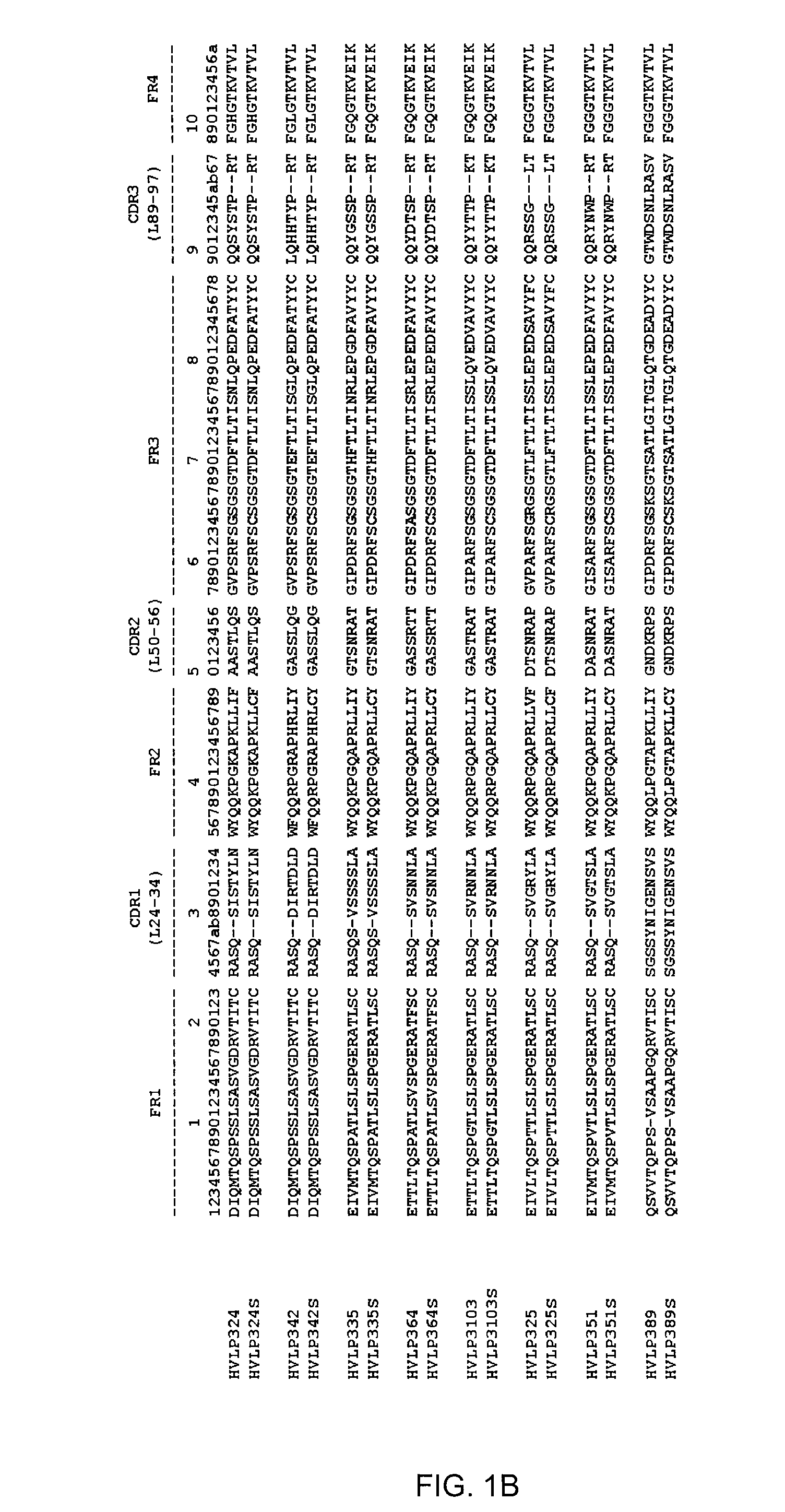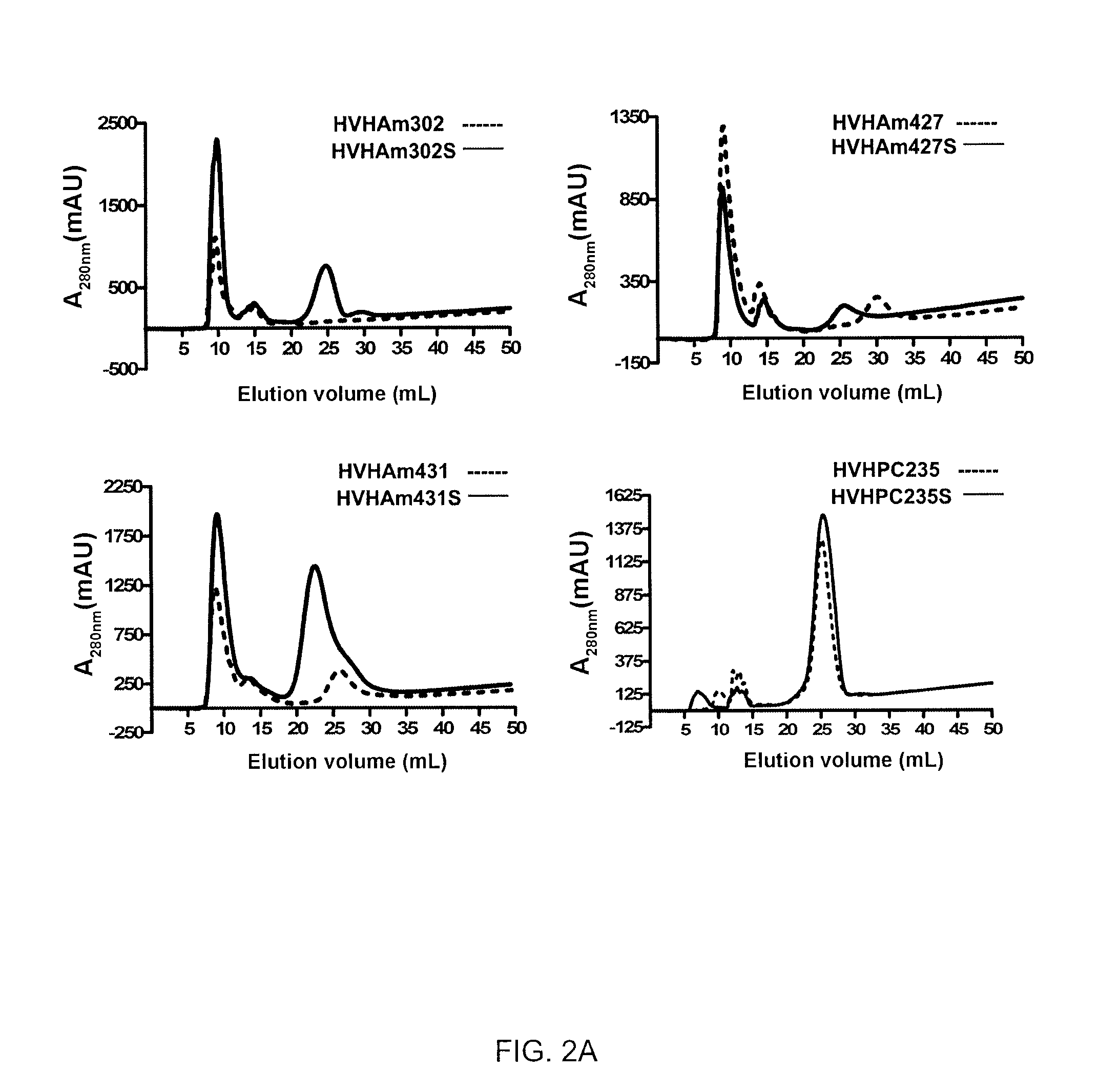Engineering of immunoglobulin domains
a technology of immunoglobulin and domain, applied in the field of immunoglobulin domain engineering, can solve the problems of poor biophysical properties, limited clinical applications, low stability, etc., and achieve the effects of improving stability, enhancing stability, and improving stability of single-domain antibodies
- Summary
- Abstract
- Description
- Claims
- Application Information
AI Technical Summary
Benefits of technology
Problems solved by technology
Method used
Image
Examples
example 1
Cloning, Expression and Purification of Mutant VHs and VLs
[0080]Aggregating and non-aggregating VH and VL domains as well as their counterpart double cysteine mutants were cloned, expressed and purified. VH and VL utilized, as well as their corresponding Cys mutants, are listed in Table 1 and shown in FIG. 1.
TABLE 1VH and VL and mutants constructed.VH*VH Cys mutantHVHAm302 (SEQ ID NO: 1)HVHAm302S (SEQ ID NO: 2)HVHAm427 (SEQ ID NO: 3)HVHAm427S (SEQ ID NO: 4)HVHAm431 (SEQ ID NO: 5)HVHAm431S (SEQ ID NO: 6)HVHPC235 (SEQ ID NO: 7)HVHPC235S (SEQ ID NO: 8)HVHP44HVHP44S (SEQ ID NO: 70)HVHB82HVHB82S (SEQ ID NO: 71)HVHP421HVHP421S (SEQ ID NO: 72)HVHP419HVHP419S (SEQ ID NO: 73)HVHP430HVHP430S (SEQ ID NO: 74)HVHP429HVHP429S (SEQ ID NO: 75)HVHM41HVHM41S (SEQ ID NO: 76)HVHM81HVHM81S (SEQ ID NO: 77)HVHP428HVHP428S (SEQ ID NO: 78)HVHP420HVHP420S (SEQ ID NO: 79)HVHP414HVHP414S (SEQ ID NO: 80)HVHP423HVHP423S (SEQ ID NO: 81)HVHP413HVHP413S (SEQ ID NO: 82)HVHP426HVHP426S (SEQ ID NO: 83)VL*VL Cys mutant...
example 2
Disulfide Linkage Mapping of Cys Mutants
[0088]Because the disulfide linkage introduced into the VH and VL Cys mutants is not natural to the antibody, the presence of disulfide linkage at the mutated position was verified prior to further characterization of the VH and VL mutants.
[0089]Based on the knowledge of the two Cys residues (Cys22 and Cys92) forming a native disulfide linkage in the wild-type VHs (Amzel and Poljak, 1979; Williams & Barclay, 1988) and the mutated residues of the mutants, the location of disulfide linkages could be predicted. Since there were some trypsin cleavage sites present between the predicted disulfide bonds in the VHs, it was possible to trypsinize the Cys mutants and utilize mass spectrometry to verify the presence of the engineered disulfide linkage.
[0090]Disulfide linkage determination for VHs and VLs was carried out as described elsewhere (Hussack et al., In press (b); Kim and Tanha, In press; Wu et al., 2009). Disulfide linkage determination for HV...
example 3
Analytical Size Exclusion Chromatography
[0096]Size exclusion chromatography (or gel filtration chromatography) separates proteins by molecular size and hydrodynamic volume (Porath and Flodin, 1959). Therefore, this method is useful in assessing protein aggregation status in solution. Size exclusion chromatography employing Superdex™ 75 is used to assess the aggregation state of VH (or VL) domains. Non-aggregating VHs (or VL) should yield chromatograms with a single, symmetrical peak with elution volumes expected for a monomeric VHs (or VLs). In contrast, the chromatogram profiles of aggregating VHs, in addition to the monomeric peaks, consist of additional peaks, e.g., large aggregates, dimeric aggregates, which elute earlier. Percent monomer can be calculated by area integration of the peaks and used as a quantitative measure of VH (or VL) aggregation tendency (the higher the % monomer of a VH (or VL), the lower its aggregation tendency and vice versa the higher the % aggregates of...
PUM
| Property | Measurement | Unit |
|---|---|---|
| Fraction | aaaaa | aaaaa |
| Stability | aaaaa | aaaaa |
Abstract
Description
Claims
Application Information
 Login to View More
Login to View More - R&D
- Intellectual Property
- Life Sciences
- Materials
- Tech Scout
- Unparalleled Data Quality
- Higher Quality Content
- 60% Fewer Hallucinations
Browse by: Latest US Patents, China's latest patents, Technical Efficacy Thesaurus, Application Domain, Technology Topic, Popular Technical Reports.
© 2025 PatSnap. All rights reserved.Legal|Privacy policy|Modern Slavery Act Transparency Statement|Sitemap|About US| Contact US: help@patsnap.com



